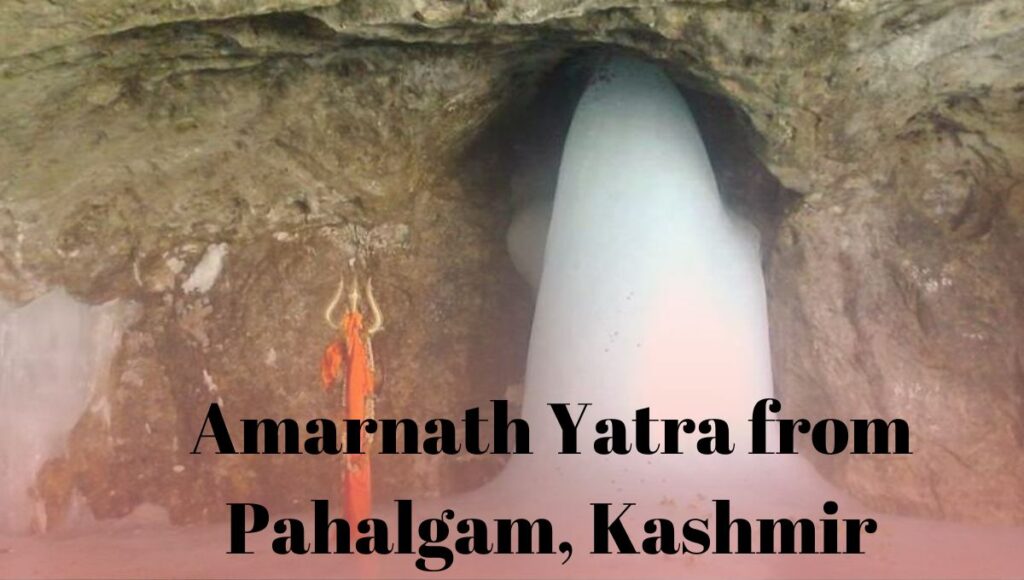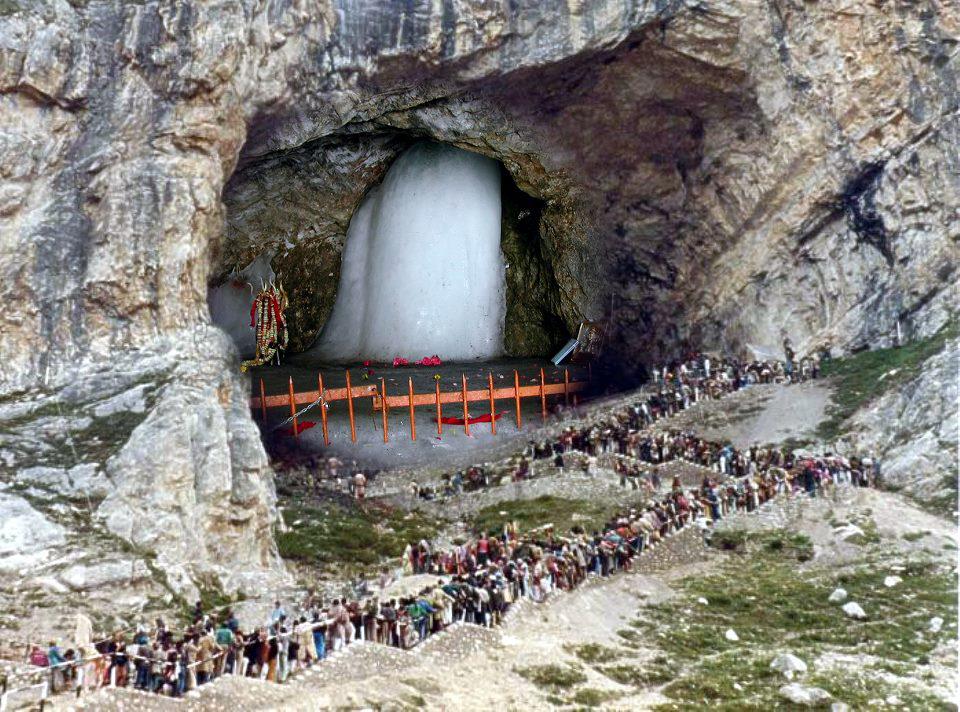
journey. For those eager to embark on this pilgrimage, understanding how to plan your Amarnath Yatra from Pahalgam is key to ensuring a smooth and fulfilling experience. In this guide, we’ll explore everything you need to know about preparing for this remarkable journey.
 Upon reaching the Amarnath Cave, allow yourself time to absorb the surroundings. The natural ice Shiva Lingam is a sight to behold and a deeply spiritual experience. Devotees often spend hours praying and, if possible, engaging in Bhajan and Kirtan.
Upon reaching the Amarnath Cave, allow yourself time to absorb the surroundings. The natural ice Shiva Lingam is a sight to behold and a deeply spiritual experience. Devotees often spend hours praying and, if possible, engaging in Bhajan and Kirtan.
Understanding the Significance of Amarnath Yatra
The Amarnath Cave, which houses a natural Shiva Lingam formed from ice, is revered as one of the holiest shrines for Hindus. According to tradition, the cave is where Lord Shiva narrated the secrets of immortality to his consort, Parvati. Therefore, the Amarnath Yatra holds immense spiritual significance for devotees, making it a must-do pilgrimage.Why Start from Pahalgam?
Pahalgam, often referred to as the “Gateway to Amarnath,” is located approximately 95 kilometres from the capital city of Srinagar. Starting your Yatra from this charming town allows for a picturesque journey, with stunning natural landscapes surrounding you. Pahalgam is also preferred for its pleasant weather and well-developed infrastructure for pilgrims.Best Time to Visit
The Amarnath Yatra usually takes place during the summer months, specifically from June to August, coinciding with the month of Sharavan in the Hindu calendar. The exact dates vary each year, so it’s crucial to stay updated via official announcements. During this period, temperatures in Pahalgam range from 15°C to 25°C, making it suitable for trekking.Preparing for Your Yatra
Planning a successful Amarnath Yatra necessitates thorough preparation. Here’s how to get started:1. Obtain the Necessary Permits
Before you embark on the Yatra, ensure that you acquire the devotees’ registration slip. This can be done online through the official Amarnath Shrine Board’s website. It is issued on a first-come-first-serve basis, thus registering early is advisable. Keep in mind that specific categories, such as children and senior citizens, have restrictions regarding participation.2. Health and Fitness Considerations
Trekking to the Amarnath Cave requires a reasonable level of physical fitness. Prior to your Yatra, engage in regular exercise, focusing on stamina-building activities. Consult a doctor, especially if you suffer from chronic ailments, high blood pressure, or respiratory issues. Carry essential medications and a first-aid kit for emergencies.3. Packing Essentials
Being well-prepared with the right gear can make a significant difference. Here’s a checklist of essentials:- Clothing: Layered clothing is key due to fluctuating temperatures. Opt for moisture-wicking fabrics, warm jackets, thermal wear, and sturdy trekking shoes. Don’t forget a raincoat or poncho in case of unexpected rainfall.
- Backpack: Choose a lightweight, durable backpack to carry your belongings. It’s advisable to keep it compact and organised.
- Camping Supplies: A sleeping bag, a lightweight tent, and sleeping mats can be handy if you plan to camp along the route.
- Food and Snacks: While numerous food stalls are available, packing energy snacks like nuts and granola bars can be beneficial for the trek.
- Water Bottles: Staying hydrated is crucial. Invest in a good-quality, reusable water bottle.
4. Hiring Porters and Pony Services
The Yatra can be physically taxing, particularly for older pilgrims. Thus, hiring a pony or a porter can significantly ease the burden. Porters carry your luggage, while ponies can help you cover stretches of the trek. Both services can be booked in Pahalgam before starting.The Journey from Pahalgam to Amarnath
The trek from Pahalgam to Amarnath is approximately 45 kilometres, often taking 2 to 3 days to complete. The journey is filled with scenic spots and breathtaking views, making it an experience in itself.Day 1: Pahalgam to Chandanwari
Start your Yatra by travelling from Pahalgam to Chandanwari, the base point of the trek to the Amarnath Cave. The distance is about 16 kilometres, and it generally takes around 6-7 hours to reach. Expect to see stunning landscapes adorned with lush meadows and imposing mountains.Day 2: Chandanwari to Sheshnag
From Chandanwari, the next leg is to Sheshnag, which is approximately 11 kilometres away. This section features steep climbs and descents alongside the beautiful Sheshnag Lake, where many devotees take a moment to rest and meditate. Ensure you pace yourself, as altitude may induce fatigue.Day 3: Sheshnag to Amarnath Cave
The final leg of the journey takes you from Sheshnag to the Amarnath Cave, approximately 12 kilometres. Early morning treks are recommended as the weather can be unpredictable, and the cave is often covered in prayers and devotion, making it an awe-inspiring experience.Arriving at Amarnath Cave
 Upon reaching the Amarnath Cave, allow yourself time to absorb the surroundings. The natural ice Shiva Lingam is a sight to behold and a deeply spiritual experience. Devotees often spend hours praying and, if possible, engaging in Bhajan and Kirtan.
Upon reaching the Amarnath Cave, allow yourself time to absorb the surroundings. The natural ice Shiva Lingam is a sight to behold and a deeply spiritual experience. Devotees often spend hours praying and, if possible, engaging in Bhajan and Kirtan.
Offerings and Rituals
While at the cave, devotees commonly offer milk and flowers to the Shivaling. Many pilgrims also carry offerings from home, such as Sindoor or raw sugar, which are placed at the feet of the idol as a mark of respect.Safety and Precautions
Safety is paramount during the Yatra. Here are some tips to ensure a safe journey:- Travel in Groups: Trekking with a group helps to provide assistance and camaraderie.
- Stay Informed: Keep in touch with the local authorities for updates on weather conditions and safety advisories.
- Customs and Etiquette: Respect local customs, and dress modestly during the pilgrimage, as it is essential to maintain decorum in such spiritual surroundings.
Additional Tips
- Mobile Connectivity: Network availability can vary in remote areas, so inform your family about your plans beforehand.
- Respect Nature: The scenic environment must be treated with respect; avoid littering and stick to designated paths.
- Local Cuisine: Don’t miss the chance to savour local Kashmiri cuisine in Pahalgam, including Rogan Josh and Yakhni, before you set off on your trek.



